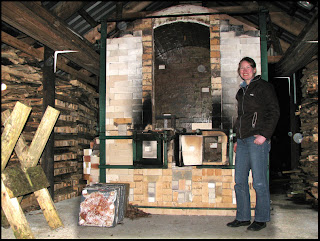Mandy Parslow - Wood Fire Potter at the Glen of Aherlow - Tops Up our Trip
We finally got to visit a potter before we left. Mandy Parslow lives in what looks like an old stone gatehouse at the foothills of the Galtee Mountains. She bought the house soon after graduating in 1994 with BA(Hons) three-dimensional design, Ceramics from Cardiff University in Wales just before the big housing boom in Ireland before housing prices skyrocketed.
"People thought I was crazy," she said, explaining that the place was worn down and in need of repair. She lived in a caravan, or travel trailer, while working on her home and studio, but some locals invited her to stay in a nearby short-term stay apartments when the weather turned cold.
 Mandy stands in front of her wood fire salt kiln that she built
Mandy stands in front of her wood fire salt kiln that she builtWe called to make an appointment with Mandy as she was teaching ceramics at the College of Art in Limerick during the week. After we climbed up a couple of steep hills and snaked around a couple of hairpin bends, we arrived at her studio/house and parked beside a double wooden gate. It was dark, and she turned on the outside light and invited us in.
We chatted and looked around her studio and showroom, and then she left us to look by ourselves as she got the tea ready. Mandy makes some lovely shapes, functional as well as decorative. She said she recently has focused on more decorative and artistic pots, but continues a line of functional pots.
I didn't get a chance to get into much detail about her work, but she had some nice pitchers, bowls, mugs, goblets and lidded jars with attached feet. What caught my attention was her line of long altered bowls, reminiscent of some kind of ancient boat, some with a combing effect up the length of each side, some with a slip that mottled nicely because of the salt. You can see one here.
We chatted and looked around her studio and showroom, and then she left us to look by ourselves as she got the tea ready. Mandy makes some lovely shapes, functional as well as decorative. She said she recently has focused on more decorative and artistic pots, but continues a line of functional pots.
I didn't get a chance to get into much detail about her work, but she had some nice pitchers, bowls, mugs, goblets and lidded jars with attached feet. What caught my attention was her line of long altered bowls, reminiscent of some kind of ancient boat, some with a combing effect up the length of each side, some with a slip that mottled nicely because of the salt. You can see one here.
 Following the advice of another potter,
Following the advice of another potter,she coated the brick inside the kiln
with a glaze before the first salting,
which reduced the amount of salt
required during initial firings
A toasty fire in the woodstove and a heated floor in her living space was the perfect setting for a cup of tea and a piece of her mother's apple tart.
Mary asked for the first cup, as she prefers a weaker brew. Her mother Helen offered up her approval of the tart, saying, "I think it's better than my own."
"That's saying something," Mary said.
Mary asked for the first cup, as she prefers a weaker brew. Her mother Helen offered up her approval of the tart, saying, "I think it's better than my own."
"That's saying something," Mary said.
 Close up of one of two stoking doors
Close up of one of two stoking doorsAfter tea, we spent a bit of time looking at Mandy's glazing and firing facilities. She has a top-loading electric kiln and a front-loading gas kiln she built inside her glaze room. Outside is her wood-fired kiln which she uses as a salt kiln. It has two stoke holes under the ware chamber. It takes her a little more than 24 hours to fire. She used to use hardwood cutoffs from a timber industry, but after the building boom fell apart, she had to switch to pine cutoffs. She built the kiln by herself with help from some students, using a design from another potter.
We swapped elbow injury stories from lifting and setting 10-pound fire bricks for days at a time, and she also mentioned having trouble with her hands turning blue from lack of circulation and nerve impingement. After consulting with a physical therapist, she decided to try swimming to help improve her condition. And it worked.
We swapped elbow injury stories from lifting and setting 10-pound fire bricks for days at a time, and she also mentioned having trouble with her hands turning blue from lack of circulation and nerve impingement. After consulting with a physical therapist, she decided to try swimming to help improve her condition. And it worked.



